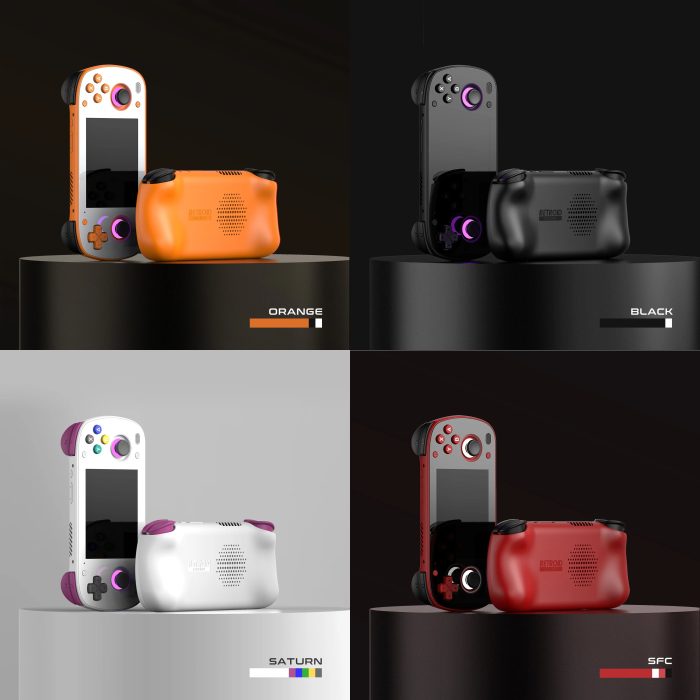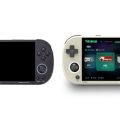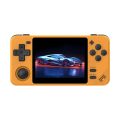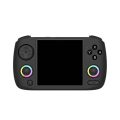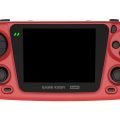If you’ve been on the lookout for a new retro handheld to satisfy your gaming nostalgia, the Retroid Pocket Mini might just catch your attention. As a retro handheld enthusiast, I was excited to get my hands on this small yet powerful console. Retroid is a brand that’s been around the block, and their hardware consistently manages to combine performance with a satisfying gaming experience.
Unboxing & First Impressions
When I first unboxed the Retroid Pocket Mini, my initial reaction was positive. The console comes in sleek packaging, complete with a USB-C charging cable, a protective foam insert, and a minimalist manual. No games or pre-installed content are included, so be prepared to set it all up yourself. The model I received was a striking black unit, and let me tell you, it has an unmistakable premium feel, thanks to the glossy front panel and ergonomic design.
The design itself is reminiscent of a PS Vita, but scaled down. It features a 3.7-inch AMOLED display, giving it a compact profile that’s easy to carry around. The surface is glassy and smooth, but you’ll want to keep a microfiber cloth handy—this console is definitely a fingerprint magnet. Still, the Retroid Pocket Mini feels solid, with textured plastic that adds grip and minimizes the visibility of smudges.
Ergonomics & Build Quality
The Retroid Pocket Mini stands out for its compact and ergonomic design. Despite being small, it’s comfortable to hold. The console features curved grips at the back, ensuring that extended gaming sessions don’t strain your hands. The hall-effect 3D joysticks are a welcome addition, offering precision and a smooth, drift-free experience. The L2 and R2 triggers are also analog, a noticeable improvement over some clicky buttons we’ve seen on other devices in this category.
However, while the buttons and joysticks impressed me, the D-pad is a mixed bag. It uses a clicky mechanism similar to the PS Vita rather than conductive rubber, and while it works well for most purposes, it has a frustrating issue where diagonal inputs can lock up during certain motions. Retroid is aware of this and promises a firmware update to fix it, so fingers crossed that the patch will come soon.
Display & Visuals
One of the standout features of the Retroid Pocket Mini is its 3.7-inch AMOLED display. With a resolution of 1280×960 at 60fps, this screen is vibrant, bright, and has impressive contrast. Games from the 16-bit and 32-bit eras look fantastic, and even PS1 titles benefit from the rich colors and deep blacks of the OLED screen. Since the display uses a 4:3 aspect ratio, it’s perfect for retro emulation, making SNES, Genesis, and PS1 games look amazing.
Unfortunately, the screen size is a bit of a double-edged sword. While it excels for older platforms, more modern systems that use a 16:9 aspect ratio—like PSP or Nintendo Wii—end up feeling cramped. The screen also doesn’t support multi-touch, which could be a limitation when mapping controls for certain games.
Performance & Hardware
Under the hood, the Retroid Pocket Mini is equipped with a Snapdragon 865 SoC, an Adreno 650 GPU, and 6GB of LPDDR4x RAM. It’s a powerful combo for a handheld of this size, and it comfortably handles a wide range of emulation tasks. Most retro platforms, including PS1, SNES, Sega Saturn, and Dreamcast, run flawlessly. Even GameCube and Wii games perform well at 720p, though some of the more graphically intensive titles require lowering the resolution slightly.
For context, the Snapdragon 865 isn’t the newest chip on the block, but it’s more than capable for retro gaming. If you’re looking to play Android games like Genshin Impact, it’ll handle them well at medium settings with stable frame rates. The console also features active cooling, which keeps temperatures in check without getting overly loud.
Where it starts to show its age is with more demanding emulation tasks, like PlayStation 2 and Nintendo Switch. While simpler PS2 games run at 2.5x native resolution without issue, heavy hitters like God of War 2 or Shadow of the Colossus require reducing settings to maintain a smooth experience. As for Nintendo Switch emulation, the Retroid Pocket Mini struggles. The Android 10 OS is a limitation here, but Retroid is expected to release Android 13 support soon, which could improve compatibility.
Gaming Experience Across Platforms
Classic Platforms
The Retroid Pocket Mini shines when emulating classic systems like NES, SNES, Sega Genesis, and Game Boy. These platforms run smoothly, and the display’s color accuracy elevates the experience. The D-pad, despite its issue with diagonal inputs, generally works well enough for most games in this category.
PlayStation 1 and Dreamcast
PlayStation 1 and Dreamcast titles look fantastic on the 4:3 OLED display. Games like Crash Bandicoot and Sonic Adventure run at higher resolutions without a hitch, and the vibrant colors make them pop. Dreamcast games, in particular, benefit from the display’s rich contrast.
PSP and Nintendo 64
PSP and Nintendo 64 emulation are hit or miss. Games like Crisis Core and Mario Kart 64 run well, but the 4:3 display results in black bars on the top and bottom, which isn’t ideal for widescreen games. If you’re mainly interested in 16:9 titles, this might not be the best choice.
GameCube and Wii
For GameCube and Wii, the performance is impressive. Titles like Mario Kart: Double Dash and The Legend of Zelda: Wind Waker are playable at 720p, with only occasional dips in frame rates. Wii games that require motion controls aren’t as fun to play without a workaround, but classic-style games fare well.
PlayStation 2
PlayStation 2 emulation is good but not perfect. Games like Final Fantasy X and Kingdom Hearts run at 2.5x native resolution, but more graphically intense games like Gran Turismo 4 struggle. It’s a similar story with Shadow of the Colossus, where the performance dips below acceptable levels unless you drop the resolution.
Android Gaming & Streaming
The Retroid Pocket Mini’s Android OS opens up a world of gaming beyond emulation. Streaming services like Xbox Cloud Gaming and Steam Link work great, thanks to the console’s Wi-Fi 6 support. Playing PC games via streaming is smooth, but again, the small screen size feels limiting for immersive titles.
Frequently Asked Questions
1. How does the Retroid Pocket Mini handle active cooling?
The Retroid Pocket Mini features an active cooling system with a small fan and ventilation grilles at the back. It pulls in air from the intake on the back and pushes it out through the top. The fan doesn’t get too loud, even when playing demanding games, but you can adjust its settings to manage noise.
2. What storage options does the Retroid Pocket Mini offer?
The console comes with 128GB of internal UFS 3.1 storage, which is plenty for most emulators and Android apps. It also includes a microSD card slot, so you can easily expand the storage and load more games.
3. How does the Retroid Pocket Mini’s build compare to other consoles?
It feels sturdy and well-made, with textured plastic on the back for added grip. Compared to some other handhelds, it feels more premium, but the glossy front surface attracts fingerprints, especially on the black model.
4. What colors are available for the Retroid Pocket Mini?
It’s available in several colors, including black, a 16-bit SNES-inspired gray with colorful buttons, a white model styled like the Sega Saturn, and a white version with orange buttons. There’s also a Super Famicom-inspired design.
5. Does the Retroid Pocket Mini come pre-loaded with any games?
No, it does not come with pre-installed games. Since it uses Android, you’ll need to download and set up emulators and provide your own game ROMs or backups.
6. How does the D-pad on the Retroid Pocket Mini perform?
The D-pad is clicky, similar to the one found on the PS Vita. While it works well for most games, it has an issue where diagonal inputs can lock up during certain motions. The company plans to release a firmware update to address this problem.
7. What version of Android does the Retroid Pocket Mini use?
It runs on Android 10, which is relatively outdated. However, an update to Android 13 is expected soon, which should improve app compatibility and overall performance.
8. Are the shoulder buttons analog or digital?
The L2 and R2 triggers are analog, allowing for variable input, which is especially useful for games that require precision, like racing games. Previous Retroid models used digital triggers, so this is a welcomed upgrade.
9. How does the Retroid Pocket Mini handle PS Vita-style games?
Its design and layout are inspired by the PS Vita, and it handles classic and retro-style games well. However, PS Vita emulation is not functional yet, and some users might miss having conductive rubber for the D-pad.
10. What’s the battery capacity, and how long does it last?
The Retroid Pocket Mini comes with a 4000mAh battery. Depending on your settings, such as screen brightness and whether the fan is on, you can expect several hours of gameplay. Lighter emulation tasks use less power, while heavy emulators and Android games can drain it faster.
11. Does the console support DisplayPort video output?
Yes, it has a USB-C port that supports DisplayPort video output. You’ll need a separate cable for this, but it can output video up to 1080p, making it a versatile device if you want to play on a larger screen.
12. How is the sound quality on the Retroid Pocket Mini?
The console has front-facing speakers hidden behind small grilles. The sound is decent, with enough volume for most games, but it’s not ultra-rich or bass-heavy. It does have a headphone jack for those who want better audio quality.
13. How does the Retroid Pocket Mini handle game streaming?
With built-in Wi-Fi 6, the console handles game streaming quite well. Services like Steam Link work smoothly if you have a strong internet connection, and the analog sticks feel precise when used for streaming PC games.
14. Does the Retroid Pocket Mini have built-in software for managing emulators?
Yes, it includes a built-in emulator frontend from Retroid. While it doesn’t automatically configure everything, it simplifies the process by setting up a basic framework, and you’ll only need to fine-tune specific settings yourself.
15. Can you adjust the performance settings of the Retroid Pocket Mini?
Yes, the device has options to change performance modes, like standard, performance, and high performance. For demanding emulators, the high-performance mode is helpful, but keep in mind that this will drain the battery faster and might increase fan noise.
Pros & Cons
Pros:
- Compact & Portable: Its small size makes it highly portable, yet it’s comfortable to hold for long periods.
- OLED Display: The 3.7-inch AMOLED screen is bright, colorful, and perfect for retro games.
- Good Build Quality: It feels premium, with quality buttons and joysticks.
- Wide Range of Emulation: Can handle up to PlayStation 2 and GameCube at decent settings.
- Wi-Fi 6 & Bluetooth 5.1: Provides reliable connectivity for online gaming and streaming.
Cons:
- Small Screen for Modern Games: The 3.7-inch 4:3 display isn’t ideal for 16:9 content or complex Android games.
- D-pad Issues: The D-pad has an annoying bug with diagonal inputs, although Retroid promises a fix.
- Aging OS: Ships with Android 10, limiting compatibility with newer apps and emulators.
- Limited Nintendo Switch Support: Struggles with more demanding games and needs an OS update to improve.
Final Thoughts
Overall, the Retroid Pocket Mini is a solid retro handheld for anyone looking to game on the go. It delivers impressive performance for its size and handles most retro platforms beautifully. That said, it does have some shortcomings, like the small screen size and occasional control issues. If you prioritize portability and love the 4:3 aspect ratio for classic games, this console is a great pick. However, if you’re after a more versatile experience, you might want to wait for the Retroid Pocket 5, which promises to address some of these concerns.
